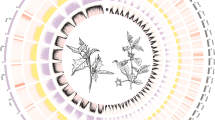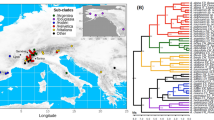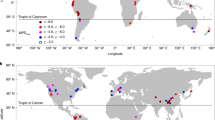Abstract
Frequencies of cyanogenic and acyanogenic plants were determined in 15 populations of white clover, Trifolium repens, representing altitudinal comparisons at five localities in southwestern British Columbia, Canada and one in northwestern Washington State, U.S.A. The percentage of cyanogenic plants averaged 53·8 per cent in low elevation (<100m) populations, 25·7 per cent in mid elevation (500–650 m) populations, and 11·6 per cent in high elevation (1000–1500 m) populations. At all of the localities except Grouse Mountain, North Vancouver, B.C., the frequency of cyanogenic plants was lowest in high elevation populations. The altitudinal ratio-cline for cyanogenesis parallels clines found in the Swiss Alps and Wales, where white clover is a native species. White clover is introduced in North America, and the cline in southwestern British Columbia must have been established in less than a century, and in some populations less than 15 years. This pattern is consistent with the hypothesis of strong selective pressure for alternative phenotypes by temperature and/or predation by slugs and snails.
Similar content being viewed by others
Article PDF
References
Angseesing, J P A. 1974. Selective eating of the acyanogenic form of Trifolium repens. Heredity, 32, 73–83.
Angseesing, J P A, and Angseesing, W J. 1973. Field observations on the cyanogenesis polymorphism in Trifolium repens. Heredity, 31, 276–282.
De Araujo, A M. 1976. The relationship between altitude and cyanogenesis in white clover (Trifolium repens L.). Heredity, 37, 291–293.
Atwood, S S, and Sullivan, J C. 1943. Inheritance of a cyanogenetic glucoside and its hydrolysing enzyme in Trifolium repens. J Hered, 34, 311–320.
Coop, I E. 1940. Cyanogenesis in white clover (Trifolium repens L.). III. A study of linamarase, the enzyme which hydrolyses lotaustralin. N Z J Sei Tech, 22, 71B–83B.
Corkill, L. 1940. Cyanogenesis in white clover (Trifolium repens L.). I. Cyanogenesis in single plants. N.Z. J. Sei. Tech, B, 22, 65–67.
Corkill, L. 1942. Cyanogenesis in white clover (Trifolium repens L.). V. The inheritance of cyanogenesis. N.Z. J. Sei. Tech B, 23, 178–193.
Crawford-Sidebotham, C J. 1972. The role of slugs and snails in the maintenance of the cyanogenesis polymorphisms of Lotus corniculatus and Trifolium repens. Heredity, 28, 405–411.
Daday, H. 1954a. Gene frequencies in wild populations of Trifolium repens L. I. Distribution by latitude. Heredity, 8, 61–78.
Daday, H. 1954b. Gene frequencies in wild populations of Trifolium repens L. II. Distribution by altitude. Heredity, 8, 377–384.
Daday, H. 1965. Gene Frequencies in Wild Populations of Trifolium Repens L. Iv. Mechanism of Natural Selection. Heredity, 20, 355–365.
Dirzo, R, and Harper, J L. 1982a. Experimental Studies On Slug-Plant Interactions. III. Differences in The Acceptability of Individual Plants of Trifolium Repens To Slugs and Snails. J Ecol, 70, 101–117.
Dirzo, R, and Harper, J L. 1982b. Experimental studies on slug-plant interactions. IV. The performance of cyanogenic and acyanogenic morphs of Trifolium repens in the field. J Ecol, 70, 119–138.
Dritschilo, W, Krummel, J, Nafus, D, and Pimentel, D. 1979. Herbivorous insects colonising cyanogenic and acyanogenic Trifolium repens. Heredity, 42, 49–56.
Ennos, R A. 1981. Detection of selection in populations of white clover (Trifolium repens L.) Biol J Linn Soc, 15, 75–82.
Foulds, W. 1977. The physiological response to moisture supply of cyanogenic and acyanogenic phenotypes of Trifolium repens L. and Lotus corniculatus L. Heredity, 39, 219–234.
Foulds, W, and Grime, J P. 1972a. The influence of soil moisture on the frequency of cyanogenic plants in populations of Trifolium repens and Lotus corniculatus. Heredity, 28, 143–146.
Foulds, W, and Grime, J P. 1972b. The response of cyanogenic and acyanogenic phenotypes of Trifolium repens to moisture supply. Heredity, 28, 181–187.
Foulds, W, and Young, L. 1977. Effect of frosting, moisture stress and potassium cyanide on the metabolism of cyanogenic and acyanogenic phenotypes of Lotus corniculatus L. and Trifolium repens L. Heredity, 38, 19–24.
Horrill, J C, and Richards, A J. 1986. Differential grazing by the mollusc Arion hortensis For. on cyanogenic and acyanogenic seedlings of the white clover, Trifolium repens L. Heredity, 56, 277–281.
Jones, D A. 1962. Selective Eating of The Acyanogenic Form of The Plant Lotus Corniculatus L., By Various Animals. Nature, 193, 1109–1110.
Jones, D A. 1966. On the polymorphism of cyanogenesis in Lotus corniculatus. I. Selection by animals. Can J Genet Cytol, 8, 556–567.
Melville, F, and Doak, B W. 1940. Cyanogenesis in white clover (Trifolium repens L.). II. Isolation of the glucosidal constituents. N Z J Sei Tech B, 22, 67–71.
Author information
Authors and Affiliations
Rights and permissions
About this article
Cite this article
Ganders, F. Altitudinal clines for cyanogenesis in introduced populations of white clover near Vancouver, Canada. Heredity 64, 387–390 (1990). https://doi.org/10.1038/hdy.1990.48
Received:
Issue date:
DOI: https://doi.org/10.1038/hdy.1990.48



